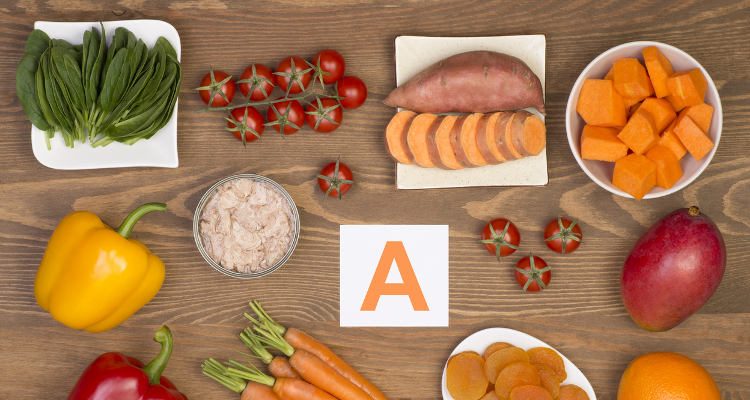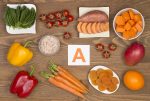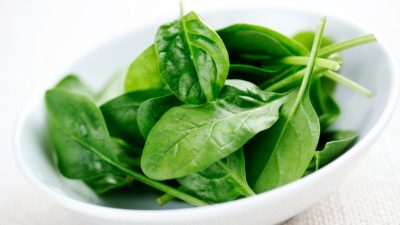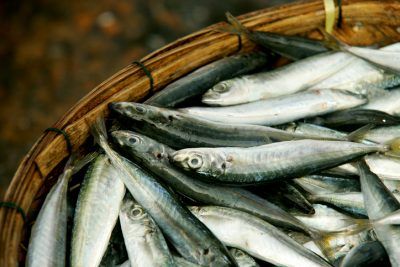
Vitamin A is a fat-soluble vitamin and a powerful antioxidant that promotes healthy skin, eye health, neurological function, and also helps to maintain strong teeth and bones. Vitamin A includes retinoids, xanthophylls, and carotenoids which the body converts to retinol. Carotenoids are water-soluble plant pigments found in yellow and orange-colored fruits and vegetables, and dark leafy greens. Kale, carrots, spinach, red bell peppers, mangoes, papayas, grapefruits are some of the foods rich in vitamin A.
Retinoids are found in animal-origin food sources. These include retinol, retinal, retinyl esters, and retinoic acid. Plant foods rich in vitamin A contain xanthophylls and carotenoids. Xanthophylls include nutrients such as astaxanthin, beta-cryptoxanthin, canthaxanthin, lutein, neoxanthin, and zeaxanthin. The types of carotenoids are alpha-, beta-, gamma-, delta-, epsilon-, and zeta-carotenes.
Retinoids and carotenoids are different in terms of their origin and chemical composition. In fact, they also offer different health benefits. Retinoids are especially useful for building immunity, good vision, reproductive health, and red blood cell formation. Carotenoids are good for eye health and have antioxidant and anti-inflammatory properties.
Our body needs the retinoid forms for most functions, so ideally we should be eating non-vegetarian foods to get retinoids. Luckily, it is alright if you are vegetarian or vegan because our body can convert carotenoids into retinoids. However, some people may have certain deficiencies and digestion issues due to which their body may not be able to convert carotenoids into retinoids. This may lead to an accumulation of unabsorbed carotenoids in the body. In such a case, consult your doctor to rectify the issue.
Here is a list of foods rich in vitamin A, along with the percentage of daily recommended intake each one provides.
Vegetable and Spice Foods Rich in Vitamin A
1. Butternut squash
Yellowish-orange colored butternut squash contains good amount of beta-carotene. A 40-gram serving of this vegetable contains 11,155 IU of vitamin A.
2. Mustard greens
Mustard greens are more nutritious compared to other leafy vegetables. They can be consumed raw or cooked. This food is rich in vitamin A and provides 118% of the daily recommended intake of vitamin A per cup. They are rich in flavor and can be added to soups and stews, and are also the richest source of calcium, carotenes, manganese, folate, protein, fiber, vitamin C, vitamin K, vitamin E, and antioxidants.
3. Dried basil
Dried basil has a unique flavor and it can be added to many dishes to enhance taste. This is another food rich in vitamin A that provides 15% of the daily needed amount of vitamin A in a serving of 100 grams.
4. Iceberg lettuce
The light green colored veggie has only 10 calories per cup. This vegetable is rich in vitamin A and can be added to sandwiches and salads. Iceberg lettuce is used to make Caesar salad—a delicious, healthy, and a simple recipe. A cup of iceberg lettuce provides 502 IU of vitamin A.
5. Spinach
Spinach is another food rich in vitamin A and is also a good source of vitamin C, vitamin K, manganese, iron, and calcium. A cup of spinach provides 49% of the daily recommended intake of vitamin A.
6. Kale
A cup of kale contains twice the daily recommended daily intake of vitamin A. You can add it to your diet by adding it to pasta, salads, stir fries, or smoothies.
7. Turnip greens
Turnip greens are one of the foods richest in vitamin A, and a cup of it provides more than twice the daily recommended daily intake of vitamin A. They also provide 66% of vitamin C and 20% of calcium and has only 29 calories per serving.
8. Carrots
Carrots are known for being the best food rich in vitamin A. A cup of carrots contains more than four times the daily requirement of vitamin A. These veggies are also known for improving eye health. They can be eaten raw, with hummus, added to smoothies, or salads. They also contain vitamins B, C, and K, as well as fiber and magnesium.
9. Sweet potatoes
Sweet potatoes are also foods rich in vitamin A. A medium-sized sweet potato provides 438% of the daily requirement of vitamin A. They are also a good source of dietary fiber and vitamin C.
10. Peas
A cup of peas provides 26% of the daily recommended intake of vitamin A. They are also a good source of carbohydrates, proteins, and vitamin C. They can be added to salads, soups, curry, or can be stir-fried.
11. Red bell pepper
Red bell pepper is one of the best foods rich in vitamin A. A cup of red bell pepper provides 93% of the recommended daily intake of vitamin A. It is the best source of vitamin C and also a good source of iron and dietary fiber.
12. Fortified oatmeal
Oatmeal is a good source of vitamin A and accounts for 29% of the recommended daily intake of vitamin A. Oatmeal also contains iron, calcium, carbohydrates, and proteins. It is a good breakfast cereal and also can be added to smoothies and granola bars.
13. Paprika
Can spices be foods rich in vitamin A? Absolutely. A tablespoon of paprika provides 71% of the recommended daily intake of vitamin A. Paprika has a fiery flavor and can be added to a number of dishes to enhance taste. It also contains good amounts of vitamin C and iron.
14. Dried marjoram
A serving of 100 grams of dried marjoram provides 161% of the recommended daily intake of vitamin A. This food is rich in vitamin A. It is also one of the best sources of iron and calcium providing 460% and 199% of the recommended daily intake, respectively.
Fruits and Dried Fruit Foods Rich in Vitamin A
Fruits and dried fruits are rich sources of vitamin A foods for the eyes. Yellow or orange-colored fruits are rich in antioxidants and are the best vitamin A foods for the skin. Here is a detailed list of dried and raw fruits that are rich in vitamin A.
1. Cantaloupe
These yellow-orange-colored fruits are a good source of vitamin A. A 177-gram serving of cantaloupe contains more than the recommended daily intake of vitamin A. They are a good source of vitamin C which helps fight against infections and gives a strong immune system. They can be added to salads and desserts, or can be eaten as a snack.
2. Grapefruit
Pink or red grapefruit have higher amounts of vitamin A compared to the white ones. A cup of pink or red grapefruit provides 53% of recommended daily intake of vitamin A and 120% of vitamin C. It can be added to salads or eaten as a snack. It is known to be good for heart health.
3. Papaya
A cup of this orange-colored fruit contains 31% of the recommended daily intake of vitamin A. They are a good source of vitamin C, folate, potassium, and also have plenty of antioxidants. Papayas can be used for making smoothies or sorbets. You can also enjoy raw papaya with some lemon juice and black pepper sprinkled on it.
4. Peaches
One peach provides 11% of the daily intake of vitamin A. They are a good source of vitamin C, along with minerals such as phosphorus, potassium, calcium, and iron. They also contain some protein.
5. Mangoes
These sweet pulpy fruits can be added to a number of desserts and can be used to make shakes and smoothies. A cup of mango provides 25% of the recommended daily intake of vitamin A. They are a good source of minerals such as potassium, phosphorous, vitamin C, and a number of other vital minerals.
6. Guavas
Guavas can be consumed raw, in the form of juice, or added to salads. They can be added to candies, jams, jellies, or desserts. They account for 21% of the daily intake of vitamin A. A guava is one of the richest sources of vitamin C and also benefits the digestive system.
7. Tangerines
Tangerines are a good source of calcium, vitamin C, and dietary fiber, along with vitamin A. They can be added to fruit salads, eaten as a snack, or consumed in the form of juices and jellies. A cup of the fruit provides 27% of the recommended daily intake of vitamin A.
8. Cherries
These tiny red-colored fruits have a good amount of vitamin A and other important vitamins and minerals. Cherries also have a high amount of antioxidants. They can be eaten as a snack or added to yogurt and salads.
9. Tomatoes
A cup of cherry tomatoes accounts for 25% of the recommended intake of vitamin A. They are also a good source of folate, vitamin K, potassium, and vitamin C. The same serving contains only 27 calories. Tomatoes are a good source of an antioxidant called lycopene that has numerous health benefits.
10. Dried apricots
Dried apricots are one of the foods rich in vitamin A, and a cup of it provides 94% of the RDI of vitamin A, 19% of iron, and seven percent of calcium. They also have 81 grams of carbohydrates containing nine grams of dietary fiber and 69 grams of sugar, so they must be consumed in moderation.
11. Prunes
Dried plums or prunes can be added to salads, juices, or sandwiches. A serving of 132 grams of prunes provides almost half of the RDI of vitamin A. They are also a good source of iron, calcium, and potassium. They help protect against cardiovascular diseases.
Animal-Origin Foods Rich in Vitamin A
As mentioned before, retinoids are found in non-vegetarian and dairy foods. The dietary sources of retinoids include animal products such as fish, dairy products, and meat. Here is the list of foods rich in retinoids.
1. Turkey liver
Turkey liver is the best food rich in vitamin A and provides 1507% of RDI. It is rich in iron, calcium, and other vital nutrients. It contains 21,700 micrgrams of retinol but is high in cholesterol.
2. Beef liver
This is another food rich in vitamin A and provides 634% of RDI per 100 grams. It is a good source of iron, folate, vitamin B12, and other vital nutrients. A 3.5-ounce serving of beef liver has 545 IU of retinol.
3. Whole milk
It is known that milk is a good source of calcium and vitamin D. But milk is also a rich source of vitamin A. The quantity of vitamin A in milk varies inversely with the fat content. The higher the fat content, the lower the amounts of vitamin A. A cup of whole milk contains 227 IU of retinol, and the same serving of non-fat milk contains 497 IU of retinol.
4. Cod liver oil
According to the US Department of Agriculture National Nutrient Database, cod liver oil and fish oil are the best sources of retinol. They both contain 30,000 micrograms of retinol each, per 100 grams.
5. Fish
Fish such as tuna, mackerel, and salmon are some of the seafoods rich in vitamin A. They are also a good source of omega-3 fatty acids and proteins. A 3.5-ounce serving of tuna fish contains 2,520 IU of retinol.
6. Dairy and poultry products
Dairy products such as sour cream, yogurt, eggs, and butter contain a good amount of retinol. The IU content of retinol in eggs, a cup of full-fat yogurt, a tablespoon of butter are 300, 243, and 317, respectively.
How Much Vitamin a Can You Consume per Day?
Adults
The U.S. recommended daily dietary allowance (RDA) of vitamin A is 900 micrograms for men, 700 micrograms for women, 770 micrograms for expectant mothers older than 19 years, and 1,300 micrograms for lactating mothers.
Children up to 13 Years
According to the U.S. Institute of Medicine of the National Academy of Sciences, the daily RDA for children up to 13 years is as per the following chart.
| Age Group | Recommended Qty |
|---|---|
| 1-3 years old | 300 micrograms |
| 4-8 years old | 400 micrograms |
| 9-13 years old | 600 micrograms |
This dosage may vary depending on the overall health, deficiencies, and the doctor’s opinion regarding the dose for a particular individual depending on these factors.
Over-Consumption of Vitamin A
Although there are plenty of foods rich in vitamin A, over-consumption of vitamin A is toxic. High intake of vitamin A causes vitamin toxicity, called hypervitaminosis A, which may lead to hair loss and skin flaking. It may also cause fluid to build up in your skull which increases pressure on your brain and can cause coma or death. This is especially applicable for vitamin A obtained from animal sources and supplements. Vitamin A found in plants is in an inactive form and does not pose any health risk.
Sources:
“Top 25 Vitamin A Rich Foods,” StyleCraze website, July 11, 2016; http://www.stylecraze.com/articles/vitamin-a-rich-foods/#gref.
“Foods Rich In Vitamin A,” Healthsomeness website; http://www.healthsomeness.com/foods-high-in/vitamin-a/, last accessed March 02, 2017.
Mae, V., “Foods Rich In Retinol : What Are The Best Sources Of Vitamin A?,” BeYouthful website, March 20, 2013;
http://beyouthful.net/foods-rich-in-retinol-what-are-the-best-sources-of-vitamin-a/.
“Vitamin A (retinol), ” Mayo Clinic web site; http://www.mayoclinic.org/drugs-supplements/vitamin-a/dosing/hrb-20060201
“vitamin A,” whfoods.com website; http://www.whfoods.com/genpage.php?tname=nutrient&dbid=106, last accessed, March 3, 2017















